My hollyhocks are finally starting to bloom. They line a fence that separates our backyard with the driveway to the back pasture. I find the driveway unattractive and like to block it from view. There is a foot path on the back-yard side of the fence, so I don’t have room for tall bushes and instead make use of tall flowers and morning glories to create a wall.
I have an odd assortment of old fashioned and double hollyhocks that have been grown from seeds, crowns, and collected seeds, some of which have since cross pollinated. The whitish ones in front have the faintest tint of pink to them; they are probably the product of the white and pink hollyhocks growing nearby. Some suggest only planting one type of hollyhock to avoid cross pollination, but I enjoy surprises!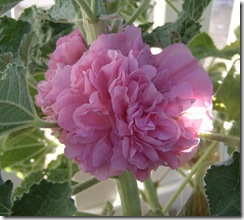
They are happiest in a sunny, well ventilated area. They prefer rich soil, but it is more important for them to be planted in well drained soil. I just add lots of rich compost to my sandy soil and they are quite content. They are susceptible to rust, so I water from below to minimize their risk to the the fungus. My husband installed a drip line because hollyhocks like an inch of water a week and our high desert clouds cannot produce that much.
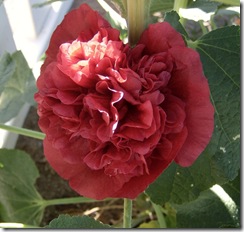
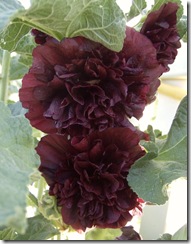
They are short-lived perennials (mine usually live 3 years) so I always have new plants starting through out the bed. It is recommended that you allow at least 2 feet in between plants and I follow that rule for the older, larger hollyhocks. However, I do allow the seedlings to develop closer to the older plants that I am hoping to replace. Hollyhocks are pretty hardy and can withstand transplanting if you find you have several seedlings growing too close together.
Hollyhocks can also be started from crowns purchased at a garden supply store. These crowns have already gone through their flowerless, leafy year and usually produce flowers the first summer after you have planted them. Some of my hollyhocks were purchased as crowns and they are on their second year of flowers for me.
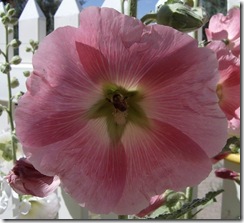
You can entertain children for hours by making hollyhock dolls. It is a fun and easy activity for a hot summer day. Follow these directions to learn How to Make Hollyhock Dolls.
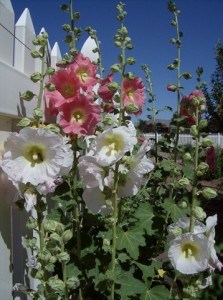

Beth says
Your hollyhocks are really pretty and this post was interesting. I have grown them for several years and they always re-seed – sometimes too much. This year was not a good year for my hollyhocks though as it was an extremely wet year and most of my plants developed rust. I do have one left that is healthy – whereas I had lots before. I will plant seeds again next year and start over. That's life in the garden! Always changing and sometimes challenging.
Beth
Maureen says
Beautiful! Hollyhocks are definitely a favorite. I remmember the singles from childhood and have had doubles. So very pretty.
Alea says
Jacqueline- I am going to do a tutorial on how to make hollyhock dolls this weekend. If you don't use chemicals on them, the pedals are edible, so we are going to make hollyhock dolls and use them on top of cupcakes.
Siteseer- The rabbits ate mine the first year, but most of them still came back. After you water them, sprinkle them with garlic powder and/or crushed red peppers. If you do that consistently for a week or two you will train the rabbits that they taste awful and they will leave them alone. I have to repeat the garlic powder/crushed pepper every spring so they young rabbits learn. 🙂 I buy the super cheap garlic powder for .50 cents at Walmart for this purpose and I save the red pepper packets that come with delivery pizza.
siteseer says
I remember as a child walking to school they would be along the fence line of several homes. This is the first year that I'm trying them. I bought about 6 perenial plants and I've noticed buds on at least one of them. Bunnies like them to my dismay 🙁 Should I take seeds from them and start more, or being perenial will they just naturally come back?
Jacqueline says
Your collection of hollyhocks are just absolutely amazing. These flowers are one of my fondest memories of growing up. We had them at home in Wisconsin and made dolls out of them every year.